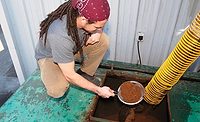Dry Processing
Centrifugal sifters before packaging help meet customer specifications

The centrifugal sifter screens ingredients to meet particle size requirements and maintain product quality.
Photo courtesy of Kason
PacMoore Products Inc., a Hammond, Ind.-based contract food manufacturer, needed equipment that would help maintain high throughput and product integrity. Two centrifugal sifters from Kason helped the company meet its quality and production goals.
PacMoore Products, founded in 1989, operates a manufacturing facility in Hammond that mainly performs dry blending and consumer packaging, and another in Mooresville, Ind., that performs spray drying and food extrusion for items such as protein-fortified crisps, snacks, cereals and TVP. The company also owns and operates a small extrusion innovation lab in Gridley, Ill.
“Ingredients typically arrive in one package format and leave in another,” says Jose Ramirez, manager of engineering and maintenance in Hammond. “We sift, blend, repackage and ship to customer manufacturing facilities or directly to retail stores.”
The plant handles a range of ingredients, including plant proteins, bakery mixes, flour blends, drink mixes, starches, sweeteners, fibers, gums, cocoa blends, protein crisps and rice. Ingredients typically arrive in 50 lb. bags, bulk bags, bulk trucks or rail cars. End products intended for retail sale leave the facility in pouches, direct-fill cartons, bag-in-box or other retail packaging. Small retail pouches range in size from 4.5 oz. (619 g) to 5 lb. (2.3 kg). Packaging for products that customers will use in further processing could be 30 lb. (13.6 kg) bag-in-box, 50 lb. (23 kg) bags, bulk bags, or whatever customers specify.
Sifting meets customer specs
To maintain high throughput and product integrity immediately prior to packaging, the Hammond plant installed two Kason Centri-Sifter centrifugal sifters. A high-capacity Model YOB-SS with a 7.5 hp (5.6 kW) motor is dedicated to the Hammond baking soda line that packages product for retail sale. A smaller 3 hp (2.2 kW) Model MO-SS is mounted on a mobile platform to insert into a second production line for products that require sifting after blending. The Mooresville plant also has a portable 3 hp unit performing final sifting when needed.
“Final centrifugal sifting guarantees the product coming out of the blender is at the right classification. This granule size is very specific and typically requested by the customer,” Ramirez says.
Blended material entering the centrifugal sifter is metered by a rigid auger into a horizontally oriented cylindrical screen, as rotating helical paddles tipped with nylon brushes create centrifugal force that propels the material against the screen.
On-size material passes through the screen and gravity discharges into a bagger. The centrifugal action also serves to break down soft agglomerates into on-size particles. Oversize particles are propelled in a helical path until they exit the downstream end of the cylinder where they discharge by gravity into an “overs” receptacle.
“A lot of the material passing through the screens can be clumpy. In a regular screener, material would build up, blind the screen, and slow our throughput, but the self-cleaning nylon brushes on the rotating paddles keep the screen clear of buildup,” says Joseph Williams, PacMoore engineering manager.
For the baking soda line at Hammond, the product arriving in rail cars is transferred to a process tank and then to the dedicated centrifugal sifter. The sifted baking soda is conveyed by rigid auger to direct-fill carton equipment, which fills retail packaging in sizes from 1 to 4 lb. (0.45 to 1.8 kg), Ramirez says.
Centrifugal vs. vibratory sifting
Williams says that circular vibratory sifters were considered for these duties, but centrifugal sifters proved the better option for final sifting, where material can be clumpy and build up on the screen. Rapid sieving action was another requirement to avoid bottlenecks.
“If we used a regular sifter like a circular vibrating screener, product clogging the screen would slow the sifting rate and the whole process,” says Williams.
High strength construction was also a requirement, to withstand jolts encountered by the mobile sifters and the continuous duty required of the permanently installed unit on the baking soda line. Portability placed additional constraints on the choice of sifters. They needed to be small enough to mount on moveable platforms, and to minimize vibration to prevent shaking of the platforms.
“The hinged door and cantilevered shaft of the Quick-Clean design allow operators to quickly remove the screen cylinder and paddle assembly without tools. This allows cleaning and inspection more easily than flat deck sifters, which is critical in food applications,” Ramirez says, citing cross-contamination as the most common reason for product recalls in the industry.
The screens last for years, Williams says. “With other sifters, we had screen breakage quite often, but have not had any with the centrifugal sifters.”
For more information, visit www.kason.com
Looking for a reprint of this article?
From high-res PDFs to custom plaques, order your copy today!








